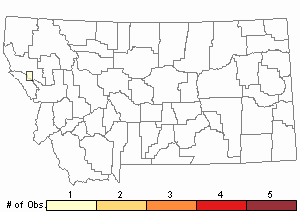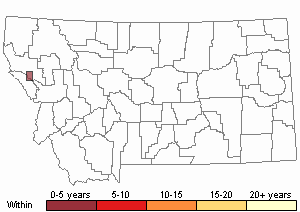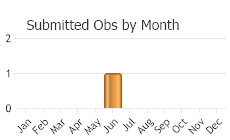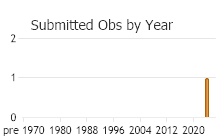View in other NatureServe Network Field Guides
NatureServe
Montana
Utah
Wyoming
Idaho
Wisconsin
British Columbia
South Carolina
Yukon
California
New York
- Home - Other Field Guides
- Kingdom - Animals - Animalia
- Phylum - Spiders, Insects, and Crustaceans - Arthropoda
- Class - Insects - Insecta
- Order - Sawflies / Wasps / Bees / Ants - Hymenoptera
- Family - Bumble, Honey, Carpenter, Stingless, & Orchid Bees - Apidae
- Species - Morrison's Bumble Bee - Bombus morrisoni
Morrison's Bumble Bee - Bombus morrisoni
General Description
For definitions and diagrams of bumble bee morphology please see the
Montana State Entomology Collection's Bumble Bee Morphology page. A short-tongued large-sized bumble bee: queens 22-26 mm in length, workers 12-22 mm. Hair very short and even in length; head short with cheek shorter than wide; mid-leg basistarsus with back far corner rounded, outer surface of hind-leg tibia flat and lacking hair (except at fringe) forming a pollen basket; hair on sides of thorax black, upper side of thorax lacking black band between wings; T1-2 yellow, T3 with at least yellow in the middle, T4-5 black. Males 15-20 mm in length; eyes greatly enlarged, much longer than eyes of any female bumble bee, and weakly convergent in the upper part; antennae long, flagellum nearly 3X longer than scape; hair color pattern similar to queens and workers, with T3 entirely yellow (Koch et al. 2012, Williams et al. 2014).
Phenology
Across the range, queens reported March to November, workers March to October, males June to November (Williams et al. 2014). In Utah, queens reported March to June, workers April to December, males May to November (Koch et al. 2012); in California, queens early March to late September, workers early June to late September, males early July to late October (Thorp et al. 1983).
Diagnostic Characteristics
Please see the
Montana State Entomology Collection's Key to Female Bumble Bees in Montana. Females told from all other Montana
Bombus by combination of outer surface of hind-leg tibia concave and lacking hairs (except fringe), forming pollen basket; T2 yellow, T3 yellow at least in middle; cheek shorter than wide; hair of thorax between wing bases predominantly yellow, if black present then forming a small spot in middle.
Range Comments
Occurs throughout the western United States to southwestern British Columbia, east to the Great Plains, south into northern Mexico, with isolated records in the Black Hills of South Dakota; possibly declining in parts of range (Williams et al. 2014). Predominantly at lower elevations between 1600-2400 m in Colorado, but to 3700 m (Macior 1974), and to at least 2710 m in California (Thorp et al. 1983).
Observations in Montana Natural Heritage Program Database
Number of Observations: 1
(Click on the following maps and charts to see full sized version)
Map Help and Descriptions
Relative Density

Recency


 (Observations spanning multiple months or years are excluded from time charts)
(Observations spanning multiple months or years are excluded from time charts)
Habitat
Occupies prairie grasslands, arid shrublands, lower montane meadows, rarely reaches above treeline to alpine tundra (Macior 1974, Kearns and Oliveras 2009, Wilson et al. 2010, Miller-Struttmann and Galen 2014, Williams et al. 2014).
Food Habits
Feeds on a variety of flowers, including Asclepias, Astragalus, Balsamorhiza, Brassica, Chrysothamnus, Cirsium, Cleome, Dalia, Delphinium, Ericameria, Erysimum, Frasera, Geranium, Helianthus, Iris, Lupinus, Melilotus, Mentzilia, Monarda, Oxytropis, Penstemon, Salvia, Senecio, Taraxacum, Thermopsis, and Trifolium (Macior 1974, Thorp et al. 1983, Wilson et al. 2010, Koch et al. 2012, Miller-Struttmann and Galen 2014, Williams et al. 2014). Also an important native pollinator of alfalfa crops (Medicago sativa) throughout the inter-mountain west (Bohart and Knowlton 1952).
Reproductive Characteristics
Nests built underground; males perch and pursue moving objects in search of queens (Williams et al. 2014). Otherwise, little information. Parasitism by cuckoo bumble bees not described.
Stewardship Responsibility
References
- Literature Cited AboveLegend:
 View Online Publication
View Online Publication Bohart, G.E. and G.F. Knowlton. 1952. Yearly population fluctuation of Bombus morrisoni at Fredonia, Arizona. Journal of Economic Entomology 45(5): 890-891.
Bohart, G.E. and G.F. Knowlton. 1952. Yearly population fluctuation of Bombus morrisoni at Fredonia, Arizona. Journal of Economic Entomology 45(5): 890-891. Kearns, C.A. and D.M. Oliveras. 2009. Boulder County bees revisited: a resampling of Boulder Colorado bees a century later. Journal of Insect Conservation 13: 603-613.
Kearns, C.A. and D.M. Oliveras. 2009. Boulder County bees revisited: a resampling of Boulder Colorado bees a century later. Journal of Insect Conservation 13: 603-613. Koch, J., J. Strange, and P. Williams. 2012. Bumble bees of the western United States. Washington, DC: USDA Forest Service, Pollinator Partnership. 143 p.
Koch, J., J. Strange, and P. Williams. 2012. Bumble bees of the western United States. Washington, DC: USDA Forest Service, Pollinator Partnership. 143 p. Macior, L.M. 1974. Pollination ecology of the Front Range of the Colorado Rocky Mountains. Melanderia 15: 1-59.
Macior, L.M. 1974. Pollination ecology of the Front Range of the Colorado Rocky Mountains. Melanderia 15: 1-59. Miller-Struttmann, N.E. and C. Galen. 2014. High-altitude multi-taskers: bumble bee food plant use broadens along an altitudinal productivity gradient. Oecologia 176:1033-1045.
Miller-Struttmann, N.E. and C. Galen. 2014. High-altitude multi-taskers: bumble bee food plant use broadens along an altitudinal productivity gradient. Oecologia 176:1033-1045. Thorp, R.W., D.S. Horning, and L.L. Dunning. 1983. Bumble bees and cuckoo bumble bees of California (Hymenoptera: Apidae). Bulletin of the California Insect Survey 23:1-79.
Thorp, R.W., D.S. Horning, and L.L. Dunning. 1983. Bumble bees and cuckoo bumble bees of California (Hymenoptera: Apidae). Bulletin of the California Insect Survey 23:1-79. Williams, P., R. Thorp, L. Richardson, and S. Colla. 2014. Bumble Bees of North America. Princeton, NJ: Princeton University Press. 208 p.
Williams, P., R. Thorp, L. Richardson, and S. Colla. 2014. Bumble Bees of North America. Princeton, NJ: Princeton University Press. 208 p. Wilson, J.S., L.E. Wilson, L.D. Loftis, and T. Griswold. 2010. The montane bee fauna of north central Washington, USA, with floral associations. Western North American Naturalist 70(2): 198-207.
Wilson, J.S., L.E. Wilson, L.D. Loftis, and T. Griswold. 2010. The montane bee fauna of north central Washington, USA, with floral associations. Western North American Naturalist 70(2): 198-207.
- Additional ReferencesLegend:
 View Online Publication
View Online Publication
Do you know of a citation we're missing? Dolan, A.C. 2016. Insects associated with Montana's huckleberry (Ericaceae: Vaccinium globulare) plants and the bumble bees (Hymenoptera: Apidae) of Montana. M.Sc. Thesis. Bozeman, MT: Montana State University. 160 p.
Dolan, A.C. 2016. Insects associated with Montana's huckleberry (Ericaceae: Vaccinium globulare) plants and the bumble bees (Hymenoptera: Apidae) of Montana. M.Sc. Thesis. Bozeman, MT: Montana State University. 160 p. Dolan, A.C., C.M. Delphia, K.M. O'Neill, and M.A. Ivie. 2017. Bumble Bees (Hymenoptera: Apidae) of Montana. Annals of the Entomological Society of America. 110(2): 129-144.
Dolan, A.C., C.M. Delphia, K.M. O'Neill, and M.A. Ivie. 2017. Bumble Bees (Hymenoptera: Apidae) of Montana. Annals of the Entomological Society of America. 110(2): 129-144. Kearns, C.A. and J.D. Thomson. 2001. The Natural History of Bumble Bees. Boulder, CO. University Press of Colorado.
Kearns, C.A. and J.D. Thomson. 2001. The Natural History of Bumble Bees. Boulder, CO. University Press of Colorado.
- Web Search Engines for Articles on "Morrison's Bumble Bee"
- Additional Sources of Information Related to "Insects"





